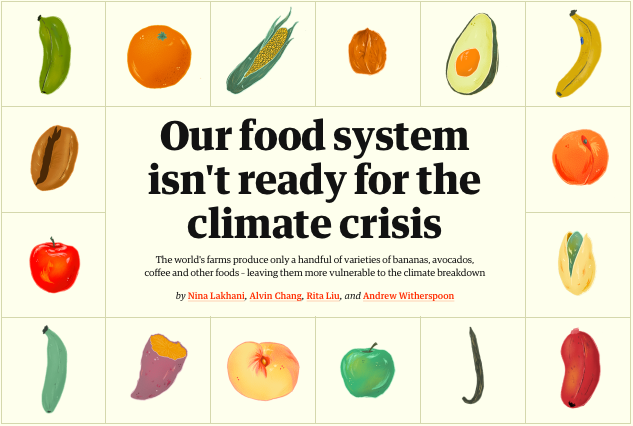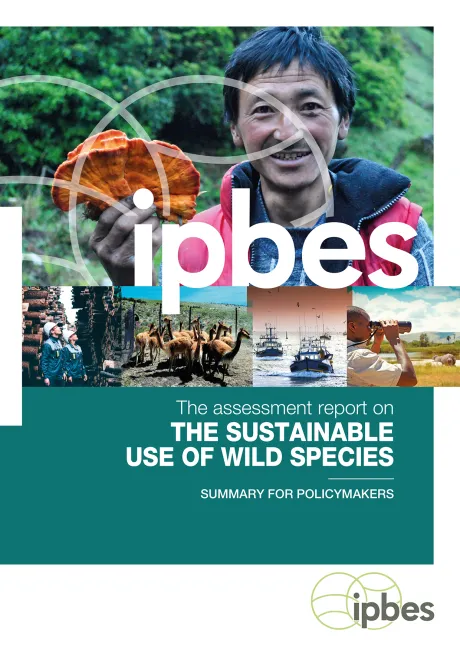Food
Description
Community members have food and nutrition security throughout the year, and are able to access to affordable, nutritious, healthy, and culturally appropriate foods for their sustenance. Many staple foods are produced or can be sourced locally and do not depend exclusively on vast global supply chains. Sustainably produced local options are available. Community members have access to foods that are safe and healthy, and can trust that food safety has been ensured including in production, handling, distribution, and storage.
Share this Subissue on:LinkedIn
Resources
Food, Planet, Health: Healthy Diets from Sustainable Food Systems
This report from the EAT-Lancet Commission on Food, Planet, Health explains the transformative changes that we must pursue as a global society to provide a healthy diet to a near-future population of 10 billion people. It highlights the shifts in eating habits and the advancements in food production and waste reduction that must be achieved to provide a healthy diet for all, and all within planetary boundaries. This report is the first full scientific review of what constitutes a healthy diet from a sustainable food system, and is a good source of information for helping you to understand the actions that can support and accelerate food system transformation.
The State of the World's Biodiversity for Food and Agriculture
This comprehensive guide from the Food and Agriculture Organization of the United Nations presents the first global assessment of biodiversity for food and agriculture worldwide. The report draws on information from 91 country reports to provide a description of the roles and importance of biodiversity for food and agriculture, the drivers of change affecting it, and its current status and trends. It describes the state of efforts to promote the sustainable use and conservation of biodiversity for food and agriculture, including through the development of supporting policies, legal frameworks, institutions and capacities. It also explains the needs and challenges of future management of biodiversity for food and agriculture. This resource is an excellent starting point for change agents to build their awareness and understanding of the vital importance of biodiversity to global food systems.
The Food Sustainability Index
Developed by the Economist Impact and Fondazione Barilla, the Food Sustainability Index (FSI) can help you understand the sustainability challenges of food systems at a national level. The FSI accounts for 78 countries, covering 92% of the global population, and focuses on three main topics: food loss and waste, sustainable agriculture, and nutritional challenges. The FSI also features a set of policy-based actions for improving food systems around the world. The focus on governmental policy makes this report especially relevant to public affairs departments that can help advocate for aligning policy with relevant governments.
Our food system isn't ready for the climate crisis
This article from the Guardian explains how many of our favourite foods - and the systems which allow them to flourish - are increasingly threatened by the climate crisis. It highlights how agriculture, forestry, fisheries, and aquaculture are all buckling under the stress of rising temperatures, wildfires, droughts, and floods, and how resilient food systems depend on cultivating and consuming a wide variety of genetically diverse foods. This compelling resource can help you to understand the recent trends in global diets and food species selection, and how communities and industry need to advance the diversity of our crops to prevent near-future food systems collapse.
The Avoidable Crisis of Food Waste: The Roadmap
This resource from Second Harvest explains how nearly 9 million metric tonnes of food is lost or wasted by the food industry in Canada each year. The report uses field-to-fork life cycle analysis to show how - and why - food loss and waste occur. This is a good starting point for building awareness around the magnitude of food waste, regardless of geographic context; for understanding the differences between avoidable and unavoidable waste; and for understanding the kinds of immediate and long-term solutions that should be pursued to reduce food loss and food waste.
Wasted Opportunity: Rescuing Surplus Food in a Throwaway Culture
This report from Second Harvest explores food loss and waste across the industrial spectrum in Canada. It can help you to understand the causes and scale of the problem, the implications and opportunities for communities and business, and solutions for positive change that can be amplified.
Although the information here is centred around the Canadian context, many of the recommendations and insights are applicable regardless of geography.
The IPBES Assessment Report on the Sustainable Use of Wild Species
Billions of people benefit daily from the use of wild species for food, energy, materials, medicine, recreation, inspiration, and more. 50,000 wild species meet the needs of billions of people worldwide, and more than 10,000 wild species are directly harvested for food. This report by the Intergovernmental Science-Policy Platform on Biodiversity and Ecosystem Services (IPBES) can help you to understand how the global biodiversity crisis threatens the contributions of these species to humanity, and provides insights, analysis, and tools to establish more sustainable use of wild species of plants, animals, fungi and algae around the world.
This report identifies five broad categories of ‘practices’ in the use of wild species: fishing; gathering; logging; terrestrial animal harvesting (including hunting); and non-extractive practices, such as observing. For each practice, it then examines specific ‘uses’ for these materials; identifies trends and drivers of change; explores policies, practices, and tools to effect positive change; and examines a range of possible future scenarios for the use of wild species.
Diets for a Better Future: Report
This report from EAT can help you understand what is needed to transition the global food system from a net source to a net sink of GHG emissions. It highlights the important role food systems play in aligning with planetary boundaries; the need for G20 countries to drastically change their food consumption patterns; the dual benefits of more sustainable foods also being healthier; and the opportunity to rethink dietary guidelines as a lever for change. This report will be especially useful to public affairs and communications teams, as well as decision-makers and change agents working in food value chains.
Solutions to Meet the Need for Feed
This white paper from the World Wildlife Fund can help you understand how the production and consumption of animal-sourced foods can be reformed to increase agricultural and community resilience and align with a 1.5°C future. It encourages collective action across four solutions areas: responsible sourcing, regenerative agriculture, circular ingredients, and feeding innovations. The insights presented will be especially useful to supply chain managers and business development teams working in the agriculture sector.
Financial Markets Roadmap for Transforming the Global Food System
This detailed report from Planet Tracker can help you understand the finance sector’s critical role in transforming the global food system - a transformation that is necessary for humanity to align with planetary boundaries and for financial institutions to meet their Net Zero ambitions. The first half of the report discusses the relationship between the finance sector and the food system’s harmful planetary impacts, and the second half focuses on how financial institutions can drive this transformation. The report sets out four food system transformation themes for aligning investment strategy with food systems change, and outlines six priority actions for financial institutions to get started on. This resource will be most useful to sustainability professionals working in the finance sector.
The State of Food Security and Nutrition in the World 2024
This annual global assessment of food security from the Food and Agriculture Organisation of the United Nations (FAO) can help you understand the major drivers of food insecurity and malnutrition. The report's four key topic areas span chapters 2 to 5. Chapter 2 features a global snapshot of food security and nutrition; chapter 3 proposes a new definition of financing for food security and nutrition; chapter 4 examines the current status of global financing to end hunger and address food insecurity and malnutrition; and chapter 5 explores options for catalysing scalable financing to fill the gaps. This assessment will be most useful to sustainability practitioners working in the agrifood sector.
Transforming Agrifood Systems Amidst the Climate Crisis: A Diversity of Solutions for People, Planet, and Prosperity
This report from the Good Food Finance Network, Tufts University, and the Environmental Defense Fund (EDF) can help you understand what the finance sector must do to support more sustainable agrifood systems. It paints a picture of the agrifood system crisis we face. and explains why system transformation is needed. It explains how this change will require new thinking that looks beyond shareholder returns to also value returns to society, and highlights a diversity of solutions needed to address complexity of this problem. It also features case studies and outlines clear calls to action along with examples for policy-makers, financiers, and businesses. These insights will be most useful to asset managers, supply chains managers, and finance teams whose organisations are involved in the agrifood sector.
The State of Food and Agriculture 2023
This detailed report from the FAO can help you understand the hidden costs created by agrifood systems globally. Using true cost accounting (TCA), the report provides estimates for the full scope of environmental, health, and social costs of food systems across 154 countries. It then explains the need for deeper, targeted TCA assessments focused on key sectors and challenges (planned for the 2024 edition of this report). The report also covers how to scale up the use of TCA to transform the food sector. These insights will be most useful to sustainability practitioners and decision-makers seeking evidence to support sustainable agrifood systems.
Future Fit Food and Agriculture
This pair of reports from the Food and Land Use Coalition, We Mean Business Coalition, and the World Business Council for Sustainable Development (WBCSD) can help you understand what food sector companies can do to prepare for the sustainability transition. The first report focuses on how companies can use climate- and nature-related voluntary frameworks and standards to prepare for future regulation, and the other focuses on how to estimate the financial implications of the sustainability transition across the value chain and how to fairly manage the burden of change. This guidance will be most useful to sustainability, supply chain, legal, and finance teams in the food sector, or for those whose investments or activities are linked with the food sector.










